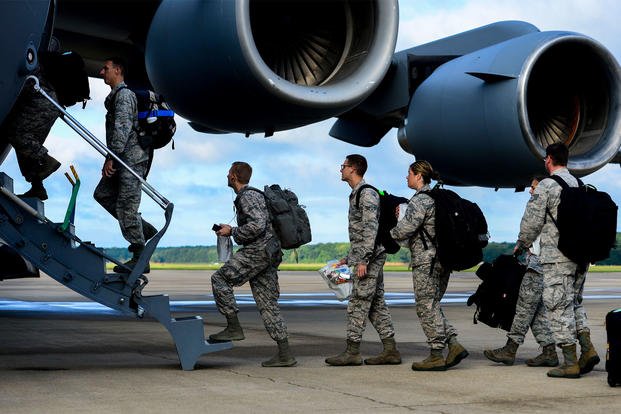Three days after the Pentagon's new deploy-or-out policy went into effect, the U.S. Army and Air Force are scrambling to finalize plans for figuring out how many non-deployable service members will have to leave the military.
It's been eight months since Defense Secretary Jim Mattis announced that the U.S. military has no place for service members who are non-deployable for more than 12 months, in a move to create a more ready force for the future.
For months, senior service leaders have said publicly they were working to finalize individual service policies.
But the Army and Air Force were not prepared to explain their plans for implementing the new policy, known as DoD Instruction 1332.45 "Retention Determinations For Non-deployable Service Members," which the Pentagon released Oct. 2.
The new policy requires each service to track and report non-deployable service members on a monthly basis and determine whether the troops in question are on temporary non-deployable or permanent non-deployable status.
The Army told Military.com it would not release non-deployable numbers at this time.
"For the Army to maintain a ready and lethal force, soldiers must be prepared to withstand the rigors of ground combat. In concert with the new Department of Defense directive, the Army is currently refining its policy for non-deployable soldiers," Army spokeswoman Col. Kathleen Turner said in a written statement.
Army Secretary Mark Esper in late August said the service has approximately 90,000 soldiers who are on some type of non-deployable status, which is roughly 9 percent of its active, National Guard and Reserve force.
Esper stressed that the Army "plays away games" and that the new policy will "send the right signal to the force."
The Air Force said "approximately 1,600" active-duty airmen are expected to be affected by the new policy, according to an Oct. 3 statement.
"The Air Force is finalizing details on how it will implement Department of Defense Instruction 1332.45. ... Until the updated policy guidance is complete in late 2018, airmen who have been non-deployable for 12 consecutive months and their commanders will continue to follow existing procedures," officials said in a statement.
Once the guidance is published, the Air Force will begin the process of evaluating the airmen for a "retention determination, referral to the Disability Evaluation System, or initiation of administrative separation, depending on each airman's circumstances," the statement says.
"It's important to understand this is not an automatic separation policy. It's a process, similar to what we already do today, that allows us to evaluate our non-deployable airmen to determine if their continued service is compatible with and can meet the requirements the nation expects of us as an Air Force," said Lt. Gen. Brian Kelly, Air Force deputy chief of staff for Manpower, Personnel and Services. "The process we create will take care of all airmen while recognizing and ensuring we have a fair and equitable deployment process across our Air Force."
Marine Corps Preparations
The Marine Corps seemed to be better prepared for the new policy. It released an Oct. 3 Marine Admin Message 564/18, Retention of Non-deployable Marines, which describes how "our process and procedures for retention and separations fall in line with the newly implemented DoD Instruction 1332.45," according to Maj. Craig Thomas, a spokesman for Marine Corps Manpower and Reserve Affairs.
"The Marine Corps has always prudently and expeditiously separated recruits and Marines who have been in a prolonged non-deployable status," he said, noting the exception of pregnant and postpartum Marines.
The main difference in the new policy, he said, is "the retention decision that was previously left to the commanding generals" will now fall to Headquarters Marine Corps Manpower and Reserve Affairs for further review and adjudication.
As of Aug. 31, the Corps had approximately 7,458 active-duty Marines who were non-deployable, excluding trainee and transient populations, Thomas said.
"This includes temporary as well as permanent non-deployable Marines," he said.
Most of these cases are medical; some are temporarily non-deployable because of illness or injury, he said.
"Our focus," Thomas said, "is to help these Marines heal as quickly as possible, so they can get back to training with their units."
Another group is considered permanently non-deployable and pending a disability evaluation.
"In those cases, the Marine Corps' goal is to seek a timely disability decision in coordination with the Department of Veterans Affairs and Department of Defense and help transition the member to life outside the military," Thomas said.
Navy Policy
U.S. Navy leaders announced the service's new policy in a Sept. 18 service-wide administrative message following a Facebook Live event.
Chief of Naval Personnel Vice Adm. Robert Burke told sailors who go 12 consecutive months without qualifying for sea duty, "you're subject to processing for administrative separation."
The Navy message states that the new policy will hold sailors responsible if they are non-deployable because of missing required medical and dental appointments.
"Ultimately, it is the personal responsibility of every sailor to maintain individual readiness including medical, dental" and other readiness categories, it states.
This seems to run counter to the new DoD policy 1332.45, which states that individual medical readiness, or IMR categories, "are not considered non-deployable conditions."
"Components are expected to immediately correct all IMR deficits to ensure service members are medically ready to deploy," according to the document, which includes examples such as "overdue dental screening" and service members who require urgent or emergent dental treatment."
The Pentagon estimates that as of Aug. 31, approximately 126,000 active-duty, National Guard and Reserve component personnel were considered non-deployable. That's roughly 6 percent of the U.S. military, taking into consideration temporary and permanent non-deployable service members, according to DoD spokeswoman Jessica Maxwell.
Under the DoD's new policy, personnel are considered temporarily non-deployable if they:
- are a patient expected to recover;
- have a medical condition that limits their full duty;
- are pregnant or postpartum;
- are a prisoner or have pending legal actions against them;
- are absent without leave or are on an unauthorized absence;
- are without a family care plan;
- are in the process of adopting a child;
- are not yet 18 years of age;
- are assigned to a location to provide support to a family member;
- are non-deployable per their respective service's discretion;
- have a pending administrative separation;
- are considered unsatisfactory participants or have administrative action pending (Reserve component only).
Exemptions will be given to those who are pregnant or postpartum, officials said.
Troops are considered permanently non-deployable if they:
- have a medical condition that permanently prevents deployment;
- are enrolled in the Disability Evaluation System;
- have a permanent profile and are awaiting a line-of-duty determination (Reserve component);
- are unable to carry a firearm;
- are the sole survivor or surviving family member;
- are deferred from hostile fire zones;
- are granted restriction of military duties in accordance with DoDI 1300.06 or "Conscientious Objection";
- are an ex-prisoner of war.
Special consideration will be given to personnel who've been wounded in combat, defense department officials said.
-- Matthew Cox can be reached at matthew.cox@military.com.
-- Oriana Pawlyk can be reached at oriana.pawlyk@military.com. Follow her on Twitter at @oriana0214.














